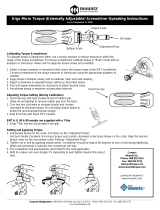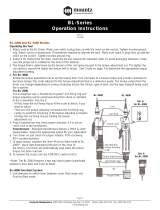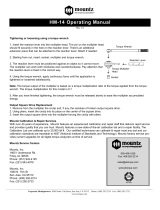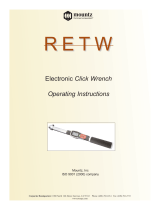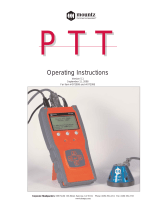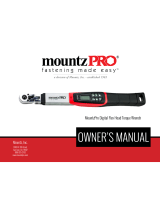Page is loading ...

K-150F models Operating Instructions
Rev 1.3
Corporate Headquarters: 1080 North 11th Street, San Jose, CA 95112 Phone: (408) 292-2214 Fax: (408) 292-2733
www.etorque.com
Operating the Tool
1. Attach cord to the K-Series Driver. Make sure notch in plug lines up with the notch on the socket. Tighten knurled ground
ring. Attach cord to the transformer. Make sure notch in plug lines up with the notch on the socket. Tighten knurled
ground ring.
2. Select a bit. Retract the bit collar. Insert the bit and release the retracted collar. To avoid damaging fasteners, make
sure the proper bit is suitable for the head of the fastener.
3. The torque limit is determined by the tension of the coil spring housed in the torque adjustment nut.
4. Rotate the torque adjustment nut to set the torque limit. Turn clockwise to increase torque and counter clockwise to
decrease torque.The scale adjacent to the Torque Adjustment Nut is a reference guide. The torque output from the
driver can change depending on various fastening factors like friction, type of joint, and the type material being used like
a washer.
5. Plug in transformer and check power indicator. If it is not on, check fuse in the transformer.
STC 30 Plus Transformer - Features a HIGH & LOW speed button. Select the appropriate speed for your
application.
6. Turn driver on and check for proper rotation. FOR-clockwise, REV-counterclockwise.
7. To apply torque, squeeze the lever (Push-to-Start models - place light downward pressure on the nose of the driver). The
driver will automatically stop when the preset torque has been reached.
8. To remove the screw, turn the FOR/REV switch to REV.
HOW TO REPLACE THE CARBON BRUSH
WARNING: When replacing the carbon brushes, detach the cord from the driver body or unplug the transformer from the
power outlet.
1. The carbon brush piece is 1/3" long when new. Change the pair when they are worn to about half the original length.
2. Insert a flat tip screwdriver into the slot in the carbon brush cap and unscrew the cap.
3. Replace the worn brushes with new pair. The contact surface of the brush is concave. Insert the brush so that the concave
end properly aligns with rounded surface of motor comutator.
CARE
1. The K-Series screwdrivers are a precision torque control instrument and should be handled with care at all times.
2. Only use the transformers listed in the Mountz catalog for appropriate K-Series driver model (If you have any questions
regarding the appropriate transformer set-up, contact Mountz Customer Service Department).
3. Operate under safe conditions. Do not place in operation where such objects as hair, strings, clothing, etc. can become
tangled in the rotating bit.
4. Keep away from moisture. Never use in high humid, moist or damp environment.
Plug for Cord
Torque Adjustment Nut
Bit Collar
Lever
Carbon
Brush Cap

Corporate Headquarters: 1080 North 11th Street, San Jose, CA 95112 Phone: (408) 292-2214 Fax: (408) 292-2733
www.etorque.com
Torque Reference Charts
The charts are meant to be used as guidelines for
setting torque. The drivers have a torque scale on the
torque adjustment nut showing reference numbers.
These numbers determine the approximate torque
setting. Z = Bronze
Accessory
The torque cover protects the K-Series from incidental
or operator tampering of torque setting.
Model Color Item #
Torque Cover Black 145615
Testing Power Tools:
1. Application Method: Use a torque analyzer in “Peak Mode” with a rotary transducer between the power tool and the actual
application. This is the best way to test since you are using the actual joint as the test station. You will see the actual
torque applied to the fastener. Caution: Variances in tool performance may occur do to the addition of the rotary
transducer.
2. Simulated Method: Always use a quality joint rate simulator (run down adapter) with a torque analyzer when testing power
tools in a simulated application. Use Joint rate and Breakaway methods to obtain most accurate torque readings in a
simulated rundown.
Maintenance Intervals:
The number of cycle shown on the table below should be used as a guideline for effective maintenance in order to reduce
unexpected down time. Maintenance intervals may be determined by the several approaches: number of cycles in use,
number of hours in use, type of joint, torque and calender time. All these factors should be considered for the best
preventative maintenance. The following inspection and replacement intervals will vary depending on tightening load and
cycle-on time.
Parts Descriptions Inspection Replacement
1. Carbon Brush 200,000 cycle 500,000 cycle
2. Power Switch 450,000 cycle 1,000,000 cycle
3. Limit Switch 450,000 cycle 1,000,000 cycle
4. F/R Switch 450,000 cycle 1,000,000 cycle
5. 1st Idle Gear (plastic) 500,000 cycle 1,000,000 cycle
6. Gear Case 800,000 cycle 1,500,000 cycle
7. Clutch 800,000 cycle 1,500,000 cycle
8. Cable (5P) 400,000 cycle 1,000,000 cycle
K-150F models Operating Instructions
Rev 1.3
408-292-2214
Fax: 408-292-2733
www.etorque.com
ISO 9001
K150F-A
1 2 3 4 5 6
Torque Scale
2
4
6
8
10
12
14
lbf.in
7
1 2 3 4 5 6
Torque Scale
2
4
6
8
10
12
14
7 8
Z
K150FP-A
lbf.in
Z

K-250 models Operating Instructions
Rev 1.3
Corporate Headquarters: 1080 North 11th Street, San Jose, CA 95112 Phone: (408) 292-2214 Fax: (408) 292-2733
www.etorque.com
Operating the Tool
1. Attach cord to the K-Series Driver. Make sure notch in plug lines up with the notch on the socket. Tighten knurled ground
ring. Attach cord to the transformer. Make sure notch in plug lines up with the notch on the socket. Tighten knurled
ground ring.
2. Select a bit. Retract the bit collar. Insert the bit and release the retracted collar. To avoid damaging fasteners, make
sure the proper bit is suitable for the head of the fastener.
3. The torque limit is determined by the tension of the coil spring housed in the torque adjustment nut.
4. Rotate the torque adjustment nut to set the torque limit. Turn clockwise to increase torque and counter clockwise to
decrease torque.The scale adjacent to the Torque Adjustment Nut is a reference guide. The torque output from the
driver can change depending on various fastening factors like friction, type of joint, and the type material being used like
a washer.
5. Plug in transformer and check power indicator. If it is not on, check fuse in the transformer.
STC 30 Plus Transformer - Features a HIGH & LOW speed button. Select the appropriate speed for your
application.
6. Turn driver on and check for proper rotation. FOR-clockwise, REV-counterclockwise.
7. To apply torque, squeeze the lever (Push-to-Start models - place light downward pressure on the nose of the driver). The
driver will automatically stop when the preset torque has been reached.
8. To remove the screw, turn the FOR/REV switch to REV.
HOW TO REPLACE THE CARBON BRUSH
WARNING: When replacing the carbon brushes, detach the cord from the driver body or unplug the transformer from the
power outlet.
1. The carbon brush piece is 1/3" long when new. Change the pair when they are worn to about half the original length.
2. Insert a flat tip screwdriver into the slot in the carbon brush cap and unscrew the cap.
3. Replace the worn brushes with new pair. The contact surface of the brush is concave. Insert the brush so that the concave
end properly aligns with rounded surface of motor comutator.
CARE
1. The K-Series screwdrivers are a precision torque control instrument and should be handled with care at all times.
2. Only use the transformers listed in the Mountz catalog for appropriate K-Series driver model (If you have any questions
regarding the appropriate transformer set-up, contact Mountz Customer Service Department).
3. Operate under safe conditions. Do not place in operation where such objects as hair, strings, clothing, etc. can become
tangled in the rotating bit.
4. Keep away from moisture. Never use in high humid, moist or damp environment.
Plug for Cord
Torque Adjustment Nut
Bit Collar
Lever
Carbon
Brush Cap

Corporate Headquarters: 1080 North 11th Street, San Jose, CA 95112 Phone: (408) 292-2214 Fax: (408) 292-2733
www.etorque.com
Torque Reference Charts
The charts are meant to be used as guidelines for setting torque. The drivers have
a torque scale on the torque adjustment nut showing reference numbers. These
numbers determine the approximate torque setting. Z = Bronze S = Silver
Accessory
The torque cover protects the K-Series from incidental or operator tampering of
torque setting.
Model Color Item #
Torque Cover Black 145615
Testing Power Tools:
1. Application Method: Use a torque analyzer in “Peak Mode” with a rotary transducer
between the power tool and the actual application. This is the best way to test since
you are using the actual joint as the test station. You will see the actual
torque applied to the fastener. Caution: Variances in tool performance may occur do
to the addition of the rotary transducer.
2. Simulated Method: Always use a quality joint rate simulator (run down adapter) with a torque analyzer when testing power
tools in a simulated application. Use Joint rate and Breakaway methods to obtain most accurate torque readings in a
simulated rundown.
Maintenance Intervals:
The number of cycle shown on the table below should be used as a guideline for effective maintenance in order to reduce
unexpected down time. Maintenance intervals may be determined by the several approaches: number of cycles in use,
number of hours in use, type of joint, torque and calender time. All these factors should be considered for the best
preventative maintenance. The following inspection and replacement intervals will vary depending on tightening load and
cycle-on time.
Parts Descriptions Inspection Replacement
1. Carbon Brush 200,000 cycle 500,000 cycle
2. Power Switch 450,000 cycle 1,000,000 cycle
3. Limit Switch 450,000 cycle 1,000,000 cycle
4. F/R Switch 450,000 cycle 1,000,000 cycle
5. 1st Idle Gear (plastic) 500,000 cycle 1,000,000 cycle
6. Gear Case 800,000 cycle 1,500,000 cycle
7. Clutch 800,000 cycle 1,500,000 cycle
8. Cable (5P) 400,000 cycle 1,000,000 cycle
K-250 models Operating Instructions
Rev 1.3
408-292-2214
Fax: 408-292-2733
www.etorque.com
ISO 9001
K250-A & K250P-A
1 2 3 4 5 6
Torque Scale
2
4
6
8
10
12
14
16
lbf.in
7 8
Z
Torque Range
1.8-14.3
18
20
22
S
Torque Range
3-21.7

K-350 models Operating Instructions
Rev 1.3
Corporate Headquarters: 1080 North 11th Street, San Jose, CA 95112 Phone: (408) 292-2214 Fax: (408) 292-2733
www.etorque.com
Operating the Tool
1. Attach cord to the K-Series Driver. Make sure notch in plug lines up with the notch on the socket. Tighten knurled ground
ring. Attach cord to the transformer. Make sure notch in plug lines up with the notch on the socket. Tighten knurled
ground ring.
2. Select a bit. Retract the bit collar. Insert the bit and release the retracted collar. To avoid damaging fasteners, make
sure the proper bit is suitable for the head of the fastener.
3. The torque limit is determined by the tension of the coil spring housed in the torque adjustment nut.
4. Rotate the torque adjustment nut to set the torque limit. Turn clockwise to increase torque and counter clockwise to
decrease torque.The scale adjacent to the Torque Adjustment Nut is a reference guide. The torque output from the
driver can change depending on various fastening factors like friction, type of joint, and the type material being used like
a washer.
5. Plug in transformer and check power indicator. If it is not on, check fuse in the transformer.
STC 30 Plus Transformer - Features a HIGH & LOW speed button. Select the appropriate speed for your
application.
6. Turn driver on and check for proper rotation. FOR-clockwise, REV-counterclockwise.
7. To apply torque, squeeze the lever (Push-to-Start models - place light downward pressure on the nose of the driver). The
driver will automatically stop when the preset torque has been reached.
8. To remove the screw, turn the FOR/REV switch to REV.
HOW TO REPLACE THE CARBON BRUSH
WARNING: When replacing the carbon brushes, detach the cord from the driver body or unplug the transformer from the
power outlet.
1. The carbon brush piece is 1/3" long when new. Change the pair when they are worn to about half the original length.
2. Insert a flat tip screwdriver into the slot in the carbon brush cap and unscrew the cap.
3. Replace the worn brushes with new pair. The contact surface of the brush is concave. Insert the brush so that the concave
end properly aligns with rounded surface of motor comutator.
CARE
1. The K-Series screwdrivers are a precision torque control instrument and should be handled with care at all times.
2. Only use the transformers listed in the Mountz catalog for appropriate K-Series driver model (If you have any questions
regarding the appropriate transformer set-up, contact Mountz Customer Service Department).
3. Operate under safe conditions. Do not place in operation where such objects as hair, strings, clothing, etc. can become
tangled in the rotating bit.
4. Keep away from moisture. Never use in high humid, moist or damp environment.
Plug for Cord
Torque Adjustment Nut
Bit Collar
Lever
Carbon
Brush Cap

Corporate Headquarters: 1080 North 11th Street, San Jose, CA 95112 Phone: (408) 292-2214 Fax: (408) 292-2733
www.etorque.com
Torque Reference Charts
The charts are meant to be used as guidelines for setting torque. The drivers have
a torque scale on the torque adjustment nut showing reference numbers. These
numbers determine the approximate torque setting. G = Gold Z = Bronze
Accessory
The torque cover protects the K-Series from incidental or operator tampering of
torque setting.
Model Color Item #
Torque Cover Black 145615
Testing Power Tools:
1. Application Method: Use a torque analyzer in “Peak Mode” with a rotary transducer
between the power tool and the actual application. This is the best way to test since
you are using the actual joint as the test station. You will see the actual
torque applied to the fastener. Caution: Variances in tool performance may occur do
to the addition of the rotary transducer.
2. Simulated Method: Always use a quality joint rate simulator (run down adapter) with a torque analyzer when testing power
tools in a simulated application. Use Joint rate and Breakaway methods to obtain most accurate torque readings in a
simulated rundown.
Maintenance Intervals:
The number of cycle shown on the table below should be used as a guideline for effective maintenance in order to reduce
unexpected down time. Maintenance intervals may be determined by the several approaches: number of cycles in use,
number of hours in use, type of joint, torque and calender time. All these factors should be considered for the best
preventative maintenance. The following inspection and replacement intervals will vary depending on tightening load and
cycle-on time.
Parts Descriptions Inspection Replacement
1. Carbon Brush 200,000 cycle 500,000 cycle
2. Power Switch 450,000 cycle 1,000,000 cycle
3. Limit Switch 450,000 cycle 1,000,000 cycle
4. F/R Switch 450,000 cycle 1,000,000 cycle
5. 1st Idle Gear (plastic) 500,000 cycle 1,000,000 cycle
6. Gear Case 800,000 cycle 1,500,000 cycle
7. Clutch 800,000 cycle 1,500,000 cycle
8. Cable (5P) 400,000 cycle 1,000,000 cycle
K-350 models Operating Instructions
Rev 1.3
408-292-2214
Fax: 408-292-2733
www.etorque.com
ISO 9001
K350-A & K350P-A
1 2 3 4 5 6
Torque Scale
5
10
15
20
25
30
35
lbf.in
7 8
G
Torque Range
10.8-30.3
Z
Torque Range
1.8-16.5

K-450 models Operating Instructions
Rev 1.3
Corporate Headquarters: 1080 North 11th Street, San Jose, CA 95112 Phone: (408) 292-2214 Fax: (408) 292-2733
www.etorque.com
Operating the Tool
1. Attach cord to the K-Series Driver. Make sure notch in plug lines up with the notch on the socket. Tighten knurled ground
ring. Attach cord to the transformer. Make sure notch in plug lines up with the notch on the socket. Tighten knurled
ground ring.
2. Select a bit. Retract the bit collar. Insert the bit and release the retracted collar. To avoid damaging fasteners, make
sure the proper bit is suitable for the head of the fastener.
3. The torque limit is determined by the tension of the coil spring housed in the torque adjustment nut.
4. Rotate the torque adjustment nut to set the torque limit. Turn clockwise to increase torque and counter clockwise to
decrease torque.The scale adjacent to the Torque Adjustment Nut is a reference guide. The torque output from the
driver can change depending on various fastening factors like friction, type of joint, and the type material being used like
a washer.
5. Plug in transformer and check power indicator. If it is not on, check fuse in the transformer.
STC 30 Plus Transformer - Features a HIGH & LOW speed button. Select the appropriate speed for your
application.
6. Turn driver on and check for proper rotation. FOR-clockwise, REV-counterclockwise.
7. To apply torque, squeeze the lever (Push-to-Start models - place light downward pressure on the nose of the driver). The
driver will automatically stop when the preset torque has been reached.
8. To remove the screw, turn the FOR/REV switch to REV.
HOW TO REPLACE THE CARBON BRUSH
WARNING: When replacing the carbon brushes, detach the cord from the driver body or unplug the transformer from the
power outlet.
1. The carbon brush piece is 1/3" long when new. Change the pair when they are worn to about half the original length.
2. Insert a flat tip screwdriver into the slot in the carbon brush cap and unscrew the cap.
3. Replace the worn brushes with new pair. The contact surface of the brush is concave. Insert the brush so that the concave
end properly aligns with rounded surface of motor comutator.
CARE
1. The K-Series screwdrivers are a precision torque control instrument and should be handled with care at all times.
2. Only use the transformers listed in the Mountz catalog for appropriate K-Series driver model (If you have any questions
regarding the appropriate transformer set-up, contact Mountz Customer Service Department).
3. Operate under safe conditions. Do not place in operation where such objects as hair, strings, clothing, etc. can become
tangled in the rotating bit.
4. Keep away from moisture. Never use in high humid, moist or damp environment.
Plug for Cord
Torque Adjustment Nut
Bit Collar
Lever
Carbon
Brush Cap

Corporate Headquarters: 1080 North 11th Street, San Jose, CA 95112 Phone: (408) 292-2214 Fax: (408) 292-2733
www.etorque.com
Torque Reference Charts
The charts are meant to be used as guidelines for setting torque. The drivers have
a torque scale on the torque adjustment nut showing reference numbers. These
numbers determine the approximate torque setting. G = Gold K = Black
Z = Bronze
Accessory
The torque cover protects the K-Series from incidental or operator tampering of
torque setting.
Model Color Item #
Torque Cover Black 145615
Testing Power Tools:
1. Application Method: Use a torque analyzer in “Peak Mode” with a rotary transducer
between the power tool and the actual application. This is the best way to test since
you are using the actual joint as the test station. You will see the actual
torque applied to the fastener. Caution: Variances in tool performance may occur do
to the addition of the rotary transducer.
2. Simulated Method: Always use a quality joint rate simulator (run down adapter) with a torque analyzer when testing power
tools in a simulated application. Use Joint rate and Breakaway methods to obtain most accurate torque readings in a
simulated rundown.
Maintenance Intervals:
The number of cycle shown on the table below should be used as a guideline for effective maintenance in order to reduce
unexpected down time. Maintenance intervals may be determined by the several approaches: number of cycles in use,
number of hours in use, type of joint, torque and calender time. All these factors should be considered for the best
preventative maintenance. The following inspection and replacement intervals will vary depending on tightening load and
cycle-on time.
Parts Descriptions Inspection Replacement
1. Carbon Brush 200,000 cycle 500,000 cycle
2. Power Switch 450,000 cycle 1,000,000 cycle
3. Limit Switch 450,000 cycle 1,000,000 cycle
4. F/R Switch 450,000 cycle 1,000,000 cycle
5. 1st Idle Gear (plastic) 500,000 cycle 1,000,000 cycle
6. Gear Case 800,000 cycle 1,500,000 cycle
7. Clutch 800,000 cycle 1,500,000 cycle
8. Cable (5P) 400,000 cycle 1,000,000 cycle
K-450 models Operating Instructions
Rev 1.3
408-292-2214
Fax: 408-292-2733
www.etorque.com
ISO 9001
K450-A & K450P-A
1 2 3 4 5 6
Torque Scale
5
10
15
20
25
30
35
lbf.in
7 8
G
Torque Range
10.8-30.3
Z
Torque
Range
2.6-14.7
K
Torque Range
14.3-39
40
/

